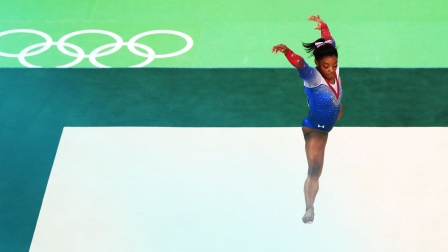Do Female Athletes Get Stiffed By The Sports Industry?
During the 2016 Olympics, the U.S. enjoyed a brief, imperfect glimpse of a rare phenomenon in sports: gender equality.
Notable gaffes in sexist Olympics coverage aside, high-profile women athletes like swimmers, gymnasts, and runners were front and center during prime-time viewing hours, and women in sports like rugby, field hockey, and shot put also got airtime. A team of researchers even found that NBC’s primetime telecast of the 2016 Rio Summer Olympics showed female athletes 58.5% of the time and male athletes 41.5% of the time during the first half of the Rio telecast.
That’s unusual. A 2015 study from the University of Southern California found that coverage of women’s sports hasn’t expanded in 25 years, despite dramatic increases in the number of girls and women playing sports, from youth through professional teams. Researchers found that Los Angeles broadcast affiliates only devote 3.2% of airtime to women’s sports—down from 5% in 1989, while ESPN’s SportsCenter has remained flat at 2% of airtime.
When women’s sports are covered, 81.6% of the coverage is focused on women’s basketball. And even when they do get on the air, the production value and commentary is often less entertaining and less professional, the study found, when compared with men’s teams.
More Than Money Issues
It’s well-known that women athletes are often paid far less than their male counterparts. Earlier this year, five members of the U.S. women’s national soccer team filed an Equal Employment Opportunity Commission complaint against the U.S. Soccer Federation for wage discrimination. To put it into perspective, even with their 2015 World Cup win, the women earned roughly a quarter of what the men earned, according to corporate gender strategist Jeffery Tobias Halter, author of Why Women: The Leadership Imperative to Advancing Women and Engaging Men.
Marketer and talent representative Leonard Armato says the lack of high-quality media coverage, as well as everything from societal attitudes about women in sports to event attendance figures, stack the deck against women athletes. Armato is CEO and founder of Management Plus Enterprises (MPE), which represents sports figures like Oscar De La Hoya, Shaquille O’Neal, and Kerri Walsh Jennings, among others, and is the former CEO and commissioner of the AVP Pro Beach Volleyball Tour which, under his direction, offered equal purses for men’s and women’s competitions.
Over the years, Armato says he’s seen the bias against women athletes firsthand. He points to one exchange with a major sneaker manufacturer regarding former WNBA star Lisa Leslie. The company wasn’t willing to negotiate her sponsorship because of doubts about her potential influence on sales.
“[They were] honest to say at one point, ‘Look, we can’t pay her a lot of money because girls are buying shoes because Michael Jordan’s wearing them, not because she’s wearing them,’” he recalls. Armato notes that in recent years, sports companies like Under Armor and Puma have penned endorsement deals with celebrities like Rihanna and Gisele Bundchen rather than opting for women athletes.
Sarah Shephard, features editor of Sport magazine in the U.K. and author of Kicking Off: How Women in Sport Are Changing the Game, agrees that cultural conditioning regarding women’s sports and lack of coverage make it difficult for women athletes to build the followings that men’s teams often command. Because women are paid so much less, they may not have the money to invest in promoting themselves and their sports. That means fewer fans in the stands and less revenue to pay athletes, as well as less representation by brands, agents, and public relations professionals.
“I know how often I am approached by PR for sportsmen, and I know how often am approached by PR for sportswomen, and there is a big difference,” she says.
In addition, paltry salaries and scarcer endorsement dollars mean that women may need to hold other jobs in addition to their sport to make ends meet. The inability to be full-time athletes can affect the level of play, Shephard says.
Moving Toward Equality
Changing the game is going to require resolving a perfect storm of factors that keep women’s teams from reaching higher profiles, earnings, and even athletic potential, Halter says. The potential market among women alone is rich: He points to the National Football League’s fast-growing audience of women and the number of women playing fantasy sports (34% of all players) as indicative of the potential fan base. But if sports organizations want to attract more female fans, Halter says, they’ll need to hire more women—on and off the field—as coaches, managers, referees, and in other posts.
“Those actions are going to demonstrate their commitment,” he says.
Brands and leagues also need to invest more in their women’s teams and athletes to build their followings, Shephard adds, in order to create a virtuous circle. By raising the profiles of women athletes, more people will become aware of them and watch them compete, which drives event attendance and sponsorship dollars.
“Sports fans will watch sports,” she says. “I am a sports fan. It does not really make any difference to me who is competing. Whether it is a men’s cycling race or women’s cycling race, you cannot tell when they have got their helmets on, anyway.”
To actually get that airtime, however, might require “radical ideas,” Armato says—perhaps even going so far as to include legislation mandating more airtime for women’s sports. He likens the idea to Congress’s 1990 enactment of the Children’s Television Act to increase the amount of educational and informational TV programming for children.
“More promotion, more companies supporting [women athletes], better time slots. You can do those little things, but I think ultimately, you’ve got to mandate that we make certain important changes like we mandated things in labor law; like we mandated things like Title IX. You’ve got to change the way people are conditioned,” Armato says. Shephard adds that sports governing bodies can also do more to advocate for more attention, media coverage, and investment on behalf of their female athletes.
Leveling the playing field in women’s sports is going to require a heavy overhaul of current conditions. But as more women get in the game, there’s never been a better time to break ground.
Fast Company , Read Full Story
(28)




